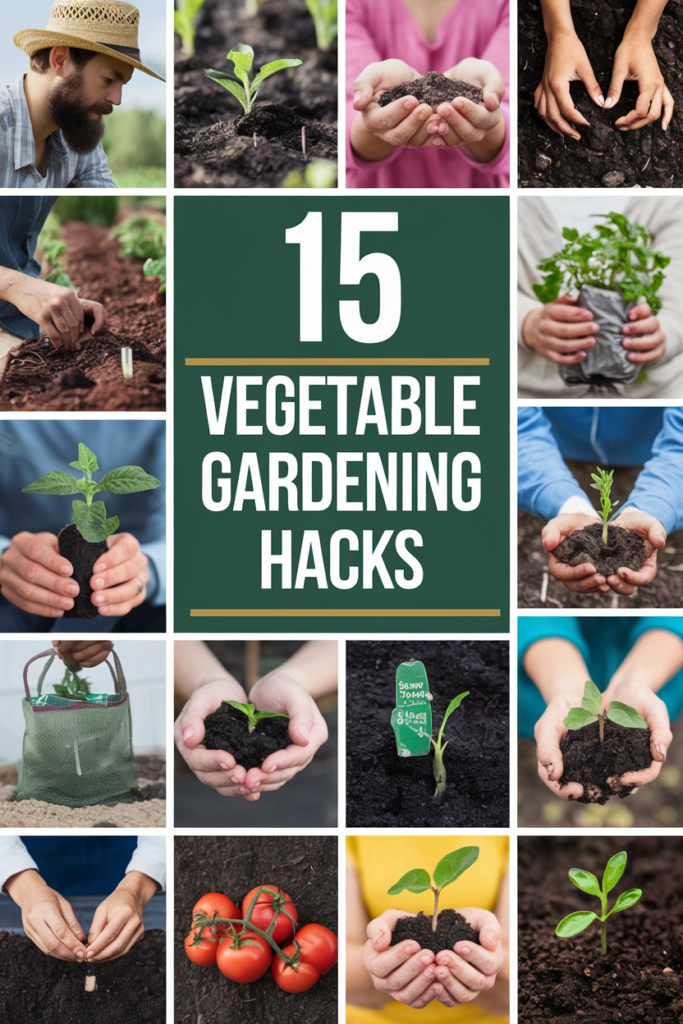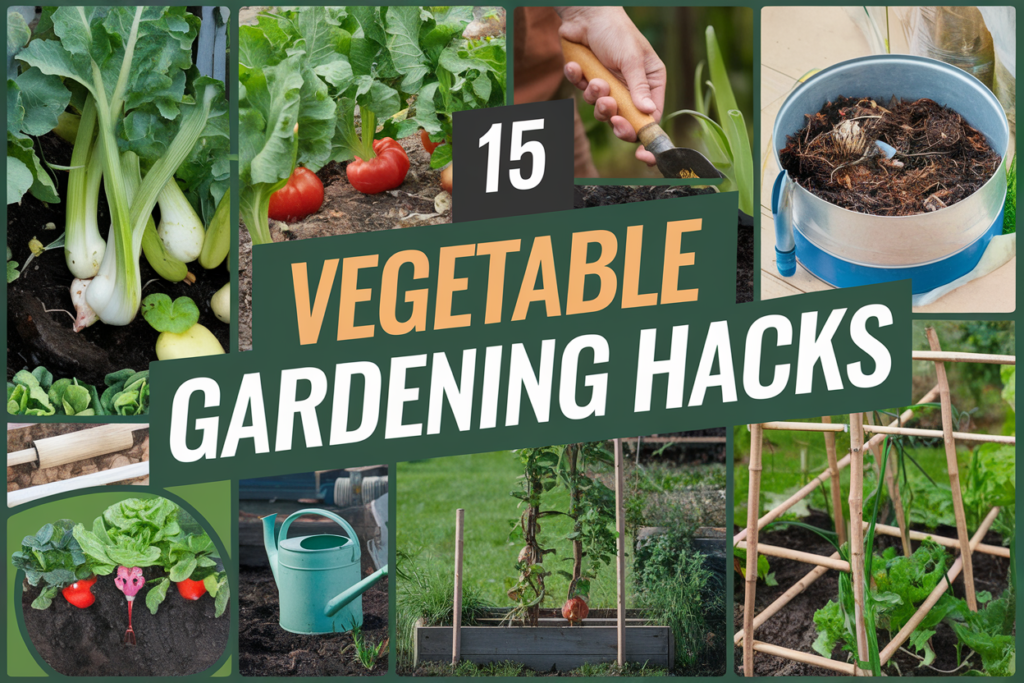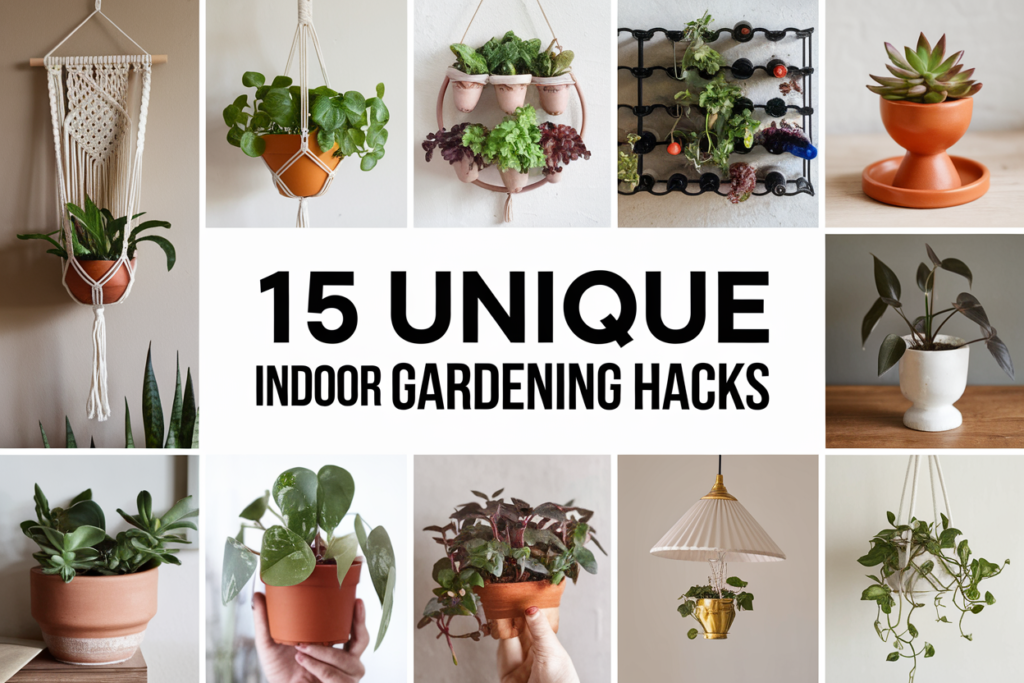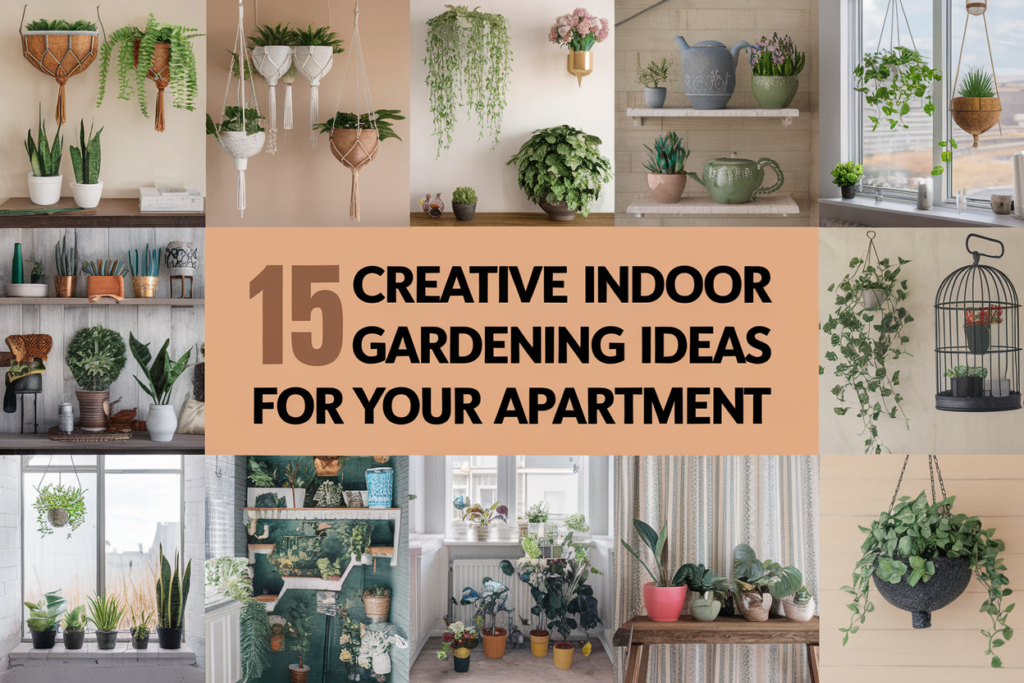If you’re looking to boost your vegetable gardening game, these 15 clever hacks will help you grow a more fruitful and vibrant garden. From simple tricks to innovative ideas, you’ll find practical solutions that every gardener can easily implement. Let’s get those plants thriving!
Companion Plant To Naturally Repel Pests And Boost Growth.
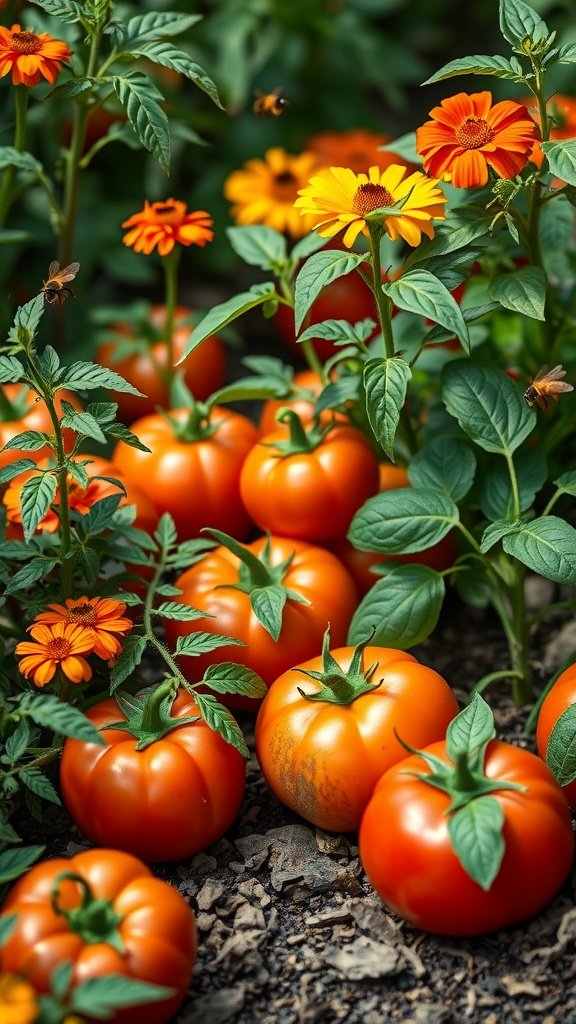
Companion planting is a fantastic way to enhance your garden. In the image, we see a vibrant mix of tomato plants and bright flowers. The tomatoes are plump and ripe, showing signs of healthy growth. The colorful flowers, likely marigolds or similar varieties, play a vital role in this setup.
These flowers attract beneficial insects like bees, which help with pollination. They also repel pests that can harm the tomatoes. This natural method reduces the need for chemicals, making your garden healthier and more eco-friendly.
When planning your garden, consider the plants you pair together. Flowers and vegetables working in harmony can lead to a more productive and thriving garden. So, grab some colorful flowers and plant them alongside your tomatoes for a bountiful harvest!
Use Coffee Grounds To Enrich Soil And Deter Slugs.
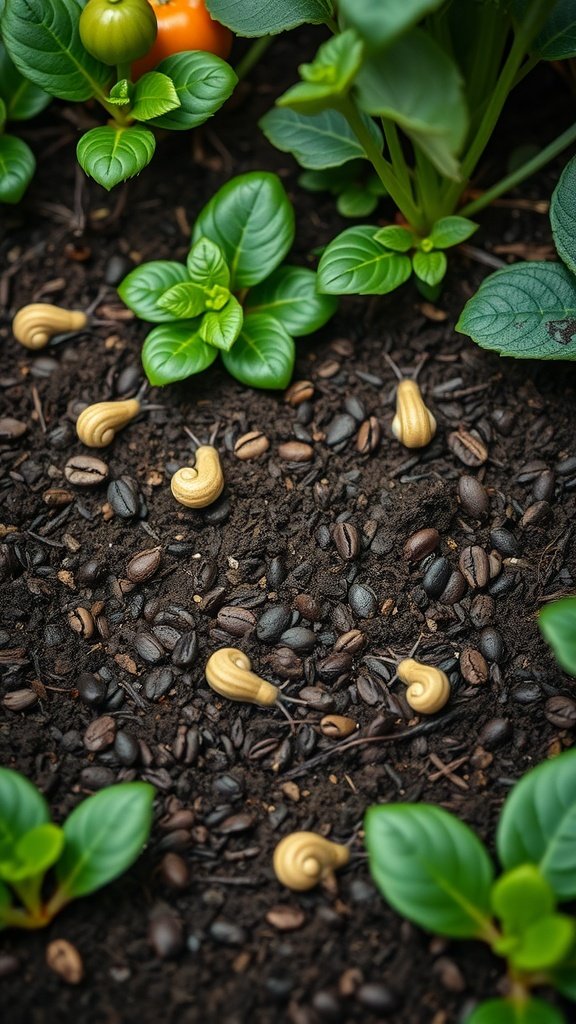
Coffee grounds are a gardener’s secret weapon! They not only enrich your soil but also help keep those pesky slugs away. In the image, you can see freshly used coffee grounds scattered around vibrant green seedlings. This simple addition can make a big difference in your garden’s health.
The coffee grounds add nitrogen to the soil, which is essential for plant growth. Also, slugs tend to avoid areas with coffee grounds because they dislike the texture and smell. This means healthier plants and fewer unwanted guests.
To use coffee grounds effectively, just mix them into your soil or sprinkle them around your plants. It’s easy, eco-friendly, and a great way to recycle your morning brew!
Reuse Egg Cartons For Starting Seedlings.
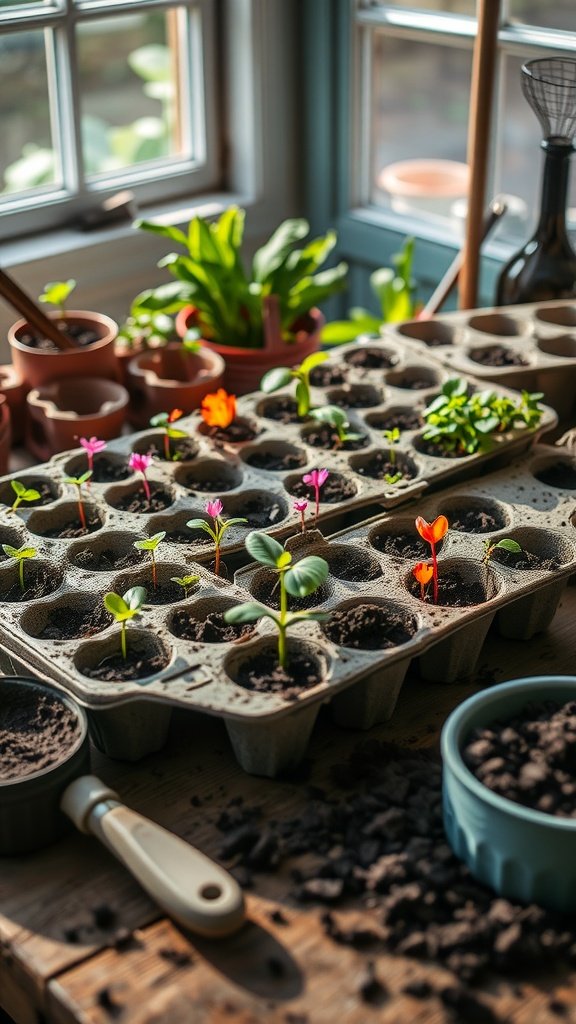
Using egg cartons to start seedlings is a smart way to recycle and save money. The image shows a cozy workspace filled with small plants sprouting in a cardboard egg carton. Each section holds a young plant, ready to grow. The vibrant colors of the seedlings make the setup look cheerful and inviting.
Egg cartons provide natural drainage and are perfect for young plants. They are easy to handle and can be placed on a sunny windowsill. Just fill each compartment with soil, plant your seeds, and keep them watered!
Once the seedlings grow strong enough, you can transplant them directly into your garden. The cardboard will decompose, enriching the soil. This method simplifies the planting process and gives your seeds a great start.
Mulch With Grass Clippings To Retain Moisture And Suppress Weeds.
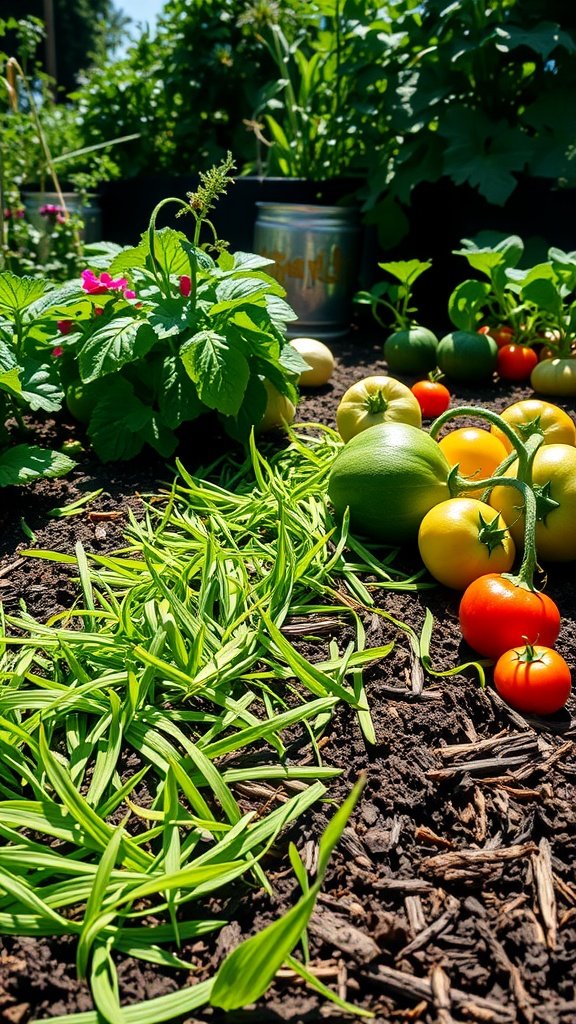
Using grass clippings as mulch can be a simple yet effective gardening hack. By spreading a layer of grass clippings around your plants, you help retain soil moisture. This is especially helpful during hot, dry months when your plants need all the hydration they can get.
The image showcases a vibrant garden scene with various vegetables and flowers. The bright green grass clippings create a striking contrast against the dark soil, indicating a healthy growing environment. You can see tomatoes in different stages of ripeness and other plants flourishing in this well-maintained space.
Weed growth is another concern for gardeners. Applying grass clippings as mulch acts like a natural barrier, helping to block sunlight from reaching weed seeds. This can significantly reduce the effort you spend on weeding, giving you more time to enjoy your garden.
Plus, using grass clippings is an eco-friendly option. They are a natural waste product that can help enrich the soil as they decompose. So, every time you mow your lawn, remember to collect those clippings for your garden!
Create Raised Beds For Better Soil Drainage And Structure.
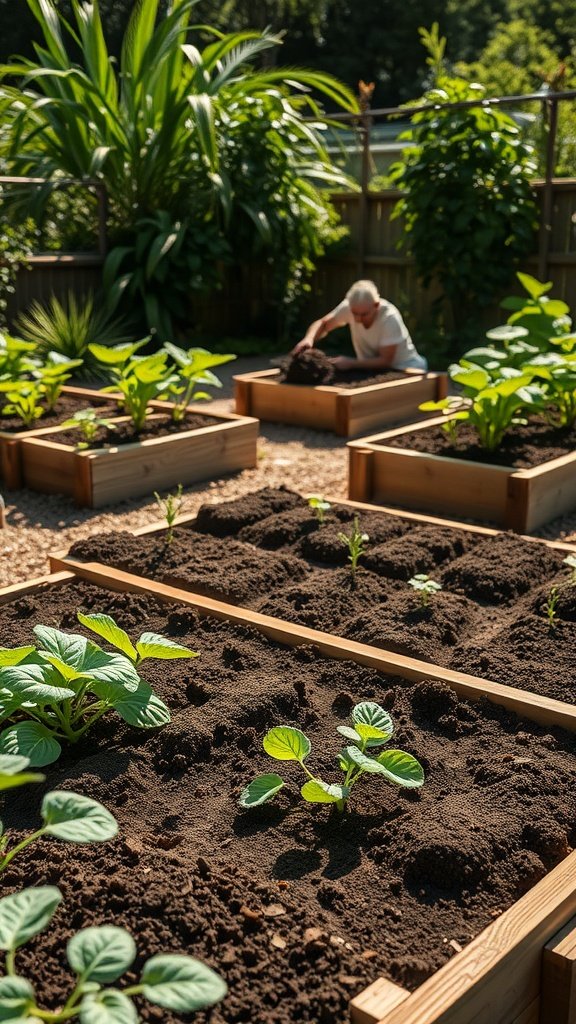
Raised beds are a fantastic way to improve your vegetable garden. They offer better soil drainage and structure, which is key for healthy plants. In the image, you can see a lovely setup of raised beds filled with rich, dark soil, perfect for growing various vegetables.
The individual tending to the garden seems focused and happy, enjoying the process of nurturing their plants. Having raised beds makes it easier to manage soil quality and moisture levels. This approach allows roots to breathe and prevents water from pooling, which can harm your plants.
The neat layout shown in the image not only looks appealing but also maximizes your gardening space. Plants grow well when they have plenty of room, and raised beds provide that! Consider adding a layer of mulch to help retain moisture and suppress weeds.
Use Old Shower Curtains As Inexpensive Weed Barriers.
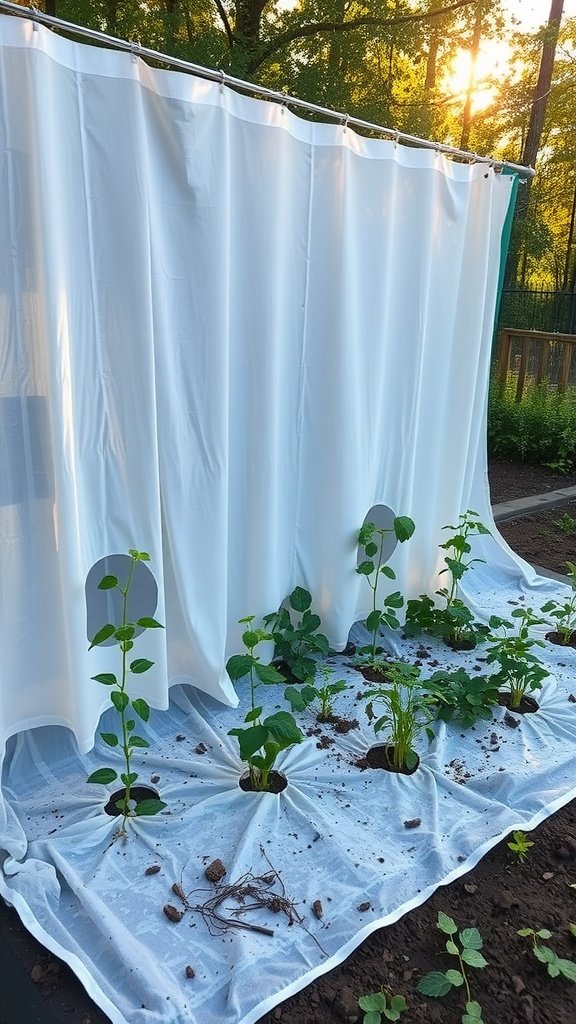
Using old shower curtains as weed barriers is a clever and cost-effective gardening hack. This method can help protect your precious vegetable seedlings.
Weeds can compete with your vegetables for nutrients and water. By placing an old shower curtain over your planting area, you block sunlight to the weeds, which helps prevent them from growing. Plus, shower curtains are often made of durable materials that can withstand outdoor conditions.
Setting it up is easy. Just lay down your shower curtain in the garden bed, ensuring it covers the soil. You can secure it with garden stakes or bricks to keep it in place. Make sure to cut holes for your plants to grow through. This way, your veggies get what they need without the hassle of weeds.
This method is not just effective; it’s also a great way to recycle. Instead of tossing out that old curtain, give it a new life in your garden. It’s a simple tip that can contribute to a thriving garden!
Grow Vegetables In Containers To Maximize Small Spaces.
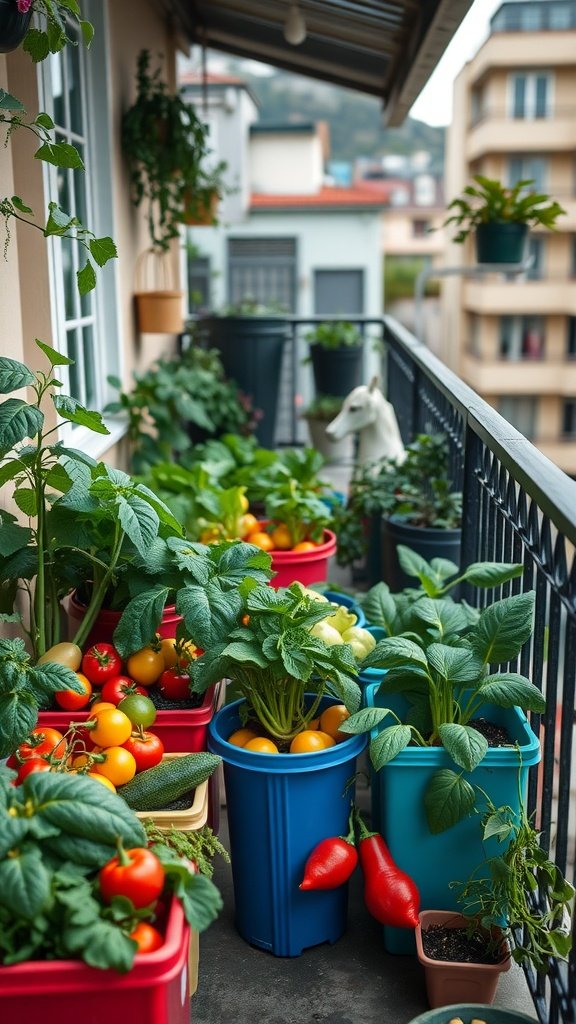
Container gardening is a great way to make the most of small spaces. Just look at this vibrant balcony filled with colorful pots overflowing with fresh vegetables. You can see tomatoes, zucchini, and peppers all thriving together. Each container is a mini-garden, showing how easy it can be to grow your own food, even if you don’t have a yard.
Using containers allows you to control the soil quality and drainage. You can mix and match your favorite veggies in a way that suits your taste and space. The variety of colors and shapes in the image highlights that gardening can be both practical and beautiful.
Don’t worry if you’re short on space; select smaller vegetable varieties that suit container life. Herbs, lettuce, and even dwarf tomatoes can flourish in pots. This method of gardening not only saves space but also makes it easier to care for your plants.
Plant Marigolds To Attract Pollinators And Repel Insects.
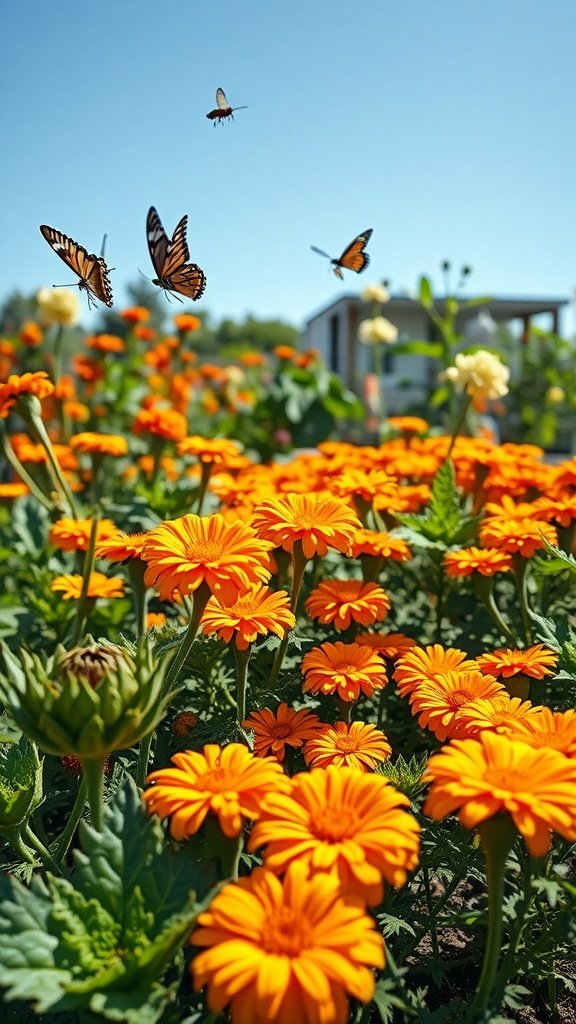
Planting marigolds in your vegetable garden can work wonders. These bright, cheerful flowers are not just beautiful; they attract beneficial pollinators like butterflies and bees. In the image, you can see a vibrant field of marigolds, filled with butterflies fluttering around. This scene highlights how these flowers can draw in pollinators that are essential for fruit and vegetable production.
Marigolds also have a unique ability to repel harmful insects. Their natural scent keeps pests like aphids and nematodes at bay. This means you can protect your veggies while adding a splash of color to your garden. Planting them near your vegetables creates a friendly and balanced ecosystem.
So, as you plan your garden layout, don’t forget to tuck in some marigolds. They are easy to grow and will enhance not just your garden’s appeal but also its productivity.
Water Early In The Morning To Prevent Evaporation.
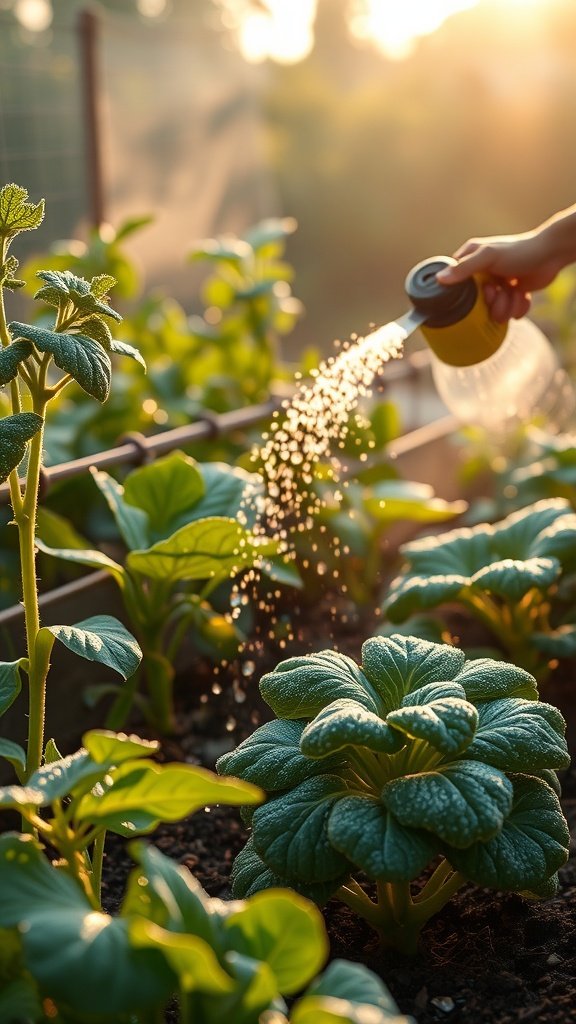
Starting your day with a refreshing morning routine can set a positive tone, and the same goes for your garden. Watering your vegetable garden in the early morning is a smart trick that helps keep your plants happy and healthy. The image captures this practice beautifully, with sunlight filtering through the leaves and droplets of water catching the light as they fall onto the soil.
When you water during the cooler hours of the morning, less water evaporates into the air. This means more moisture reaches the roots of your plants where it’s really needed. Plants can take up the water effectively and start their day off right, promoting stronger growth and vibrant vegetables.
The serene morning atmosphere, as shown in the image, not only benefits your plants but can also be a peaceful way to connect with nature. Taking a moment to enjoy the quiet and the beauty of your garden can be a delightful experience. So grab your watering can and join the plants as they wake up to a new day!
Use A Diy Drip Irrigation System For Water Efficiency.
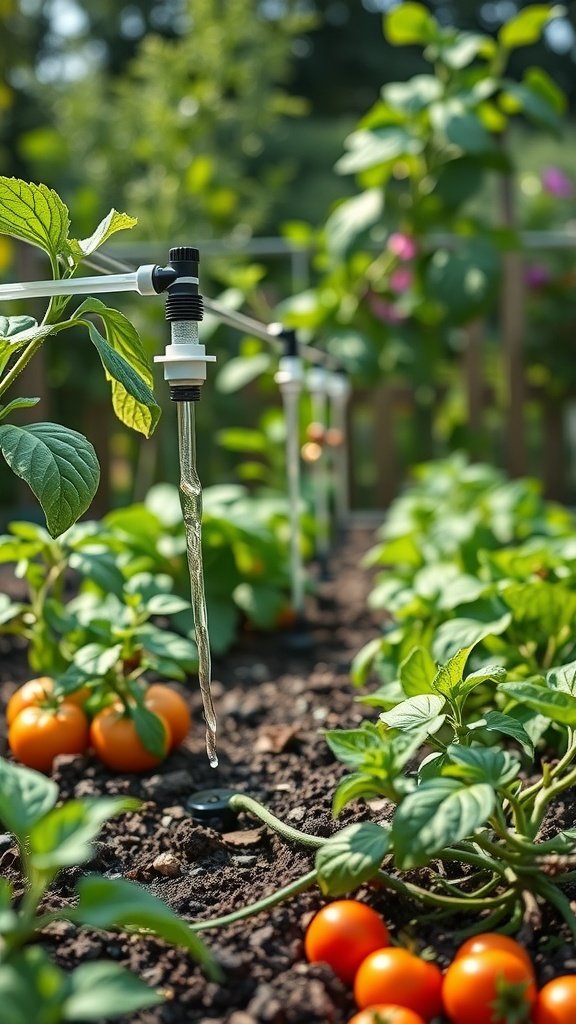
Setting up a DIY drip irrigation system can be a game changer for your vegetable garden. This system delivers water directly to the roots of your plants, ensuring they get just the right amount. In the image, you can see clear tubing and drip emitters precisely positioned among the lush green plants. This setup not only conserves water but also helps keep your garden thriving.
The beauty of a drip system is its efficiency. You can customize it to meet the specific needs of your garden, whether you’re watering tomatoes or peppers. By using simple materials like tubing, connectors, and emitters, you can create a watering solution that works for you.
Another advantage is reduced weed growth. Since water is directed only to the plants, the surrounding soil stays drier, making it less inviting for weeds. This means less time spent weeding and more time enjoying your homegrown veggies!
Rotate Crops Annually To Prevent Soil Depletion.
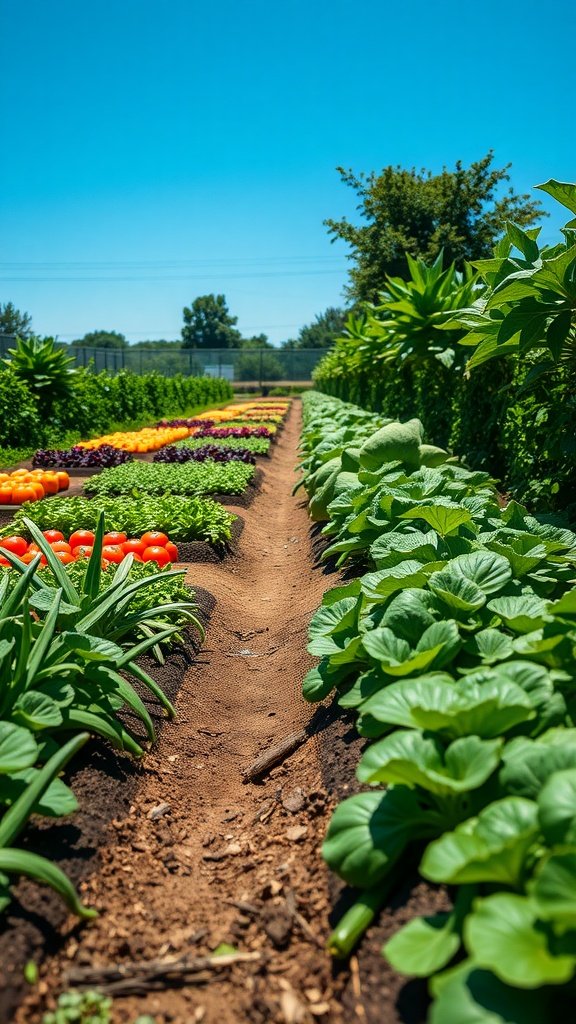
In the vibrant scene of a well-kept vegetable garden, rows of colorful plants stand proudly under a bright blue sky. This image perfectly captures the essence of crop rotation, a fundamental practice for maintaining soil health. You can see a variety of vegetables, from lush greens to bright reds and purples, all thriving together.
Crop rotation involves changing the types of vegetables planted in each area of your garden from year to year. This helps prevent nutrient depletion in the soil. Different plants require different nutrients, and rotating them ensures that no single nutrient gets overused.
Not only does this practice keep your soil nutrient-rich, but it also helps to reduce pests and diseases. When you plant the same crop in the same spot repeatedly, pests can take hold. By mixing things up, you break their cycle and keep your garden healthy.
So, when planning your garden, take a moment to think about how you can rotate your crops. It’s a simple step that leads to a flourishing garden. Just like in this photo, where a mix of vegetables thrives in harmony, your garden can be just as vibrant and healthy!
Recycle Plastic Bottles As Mini Greenhouses For Seedlings.
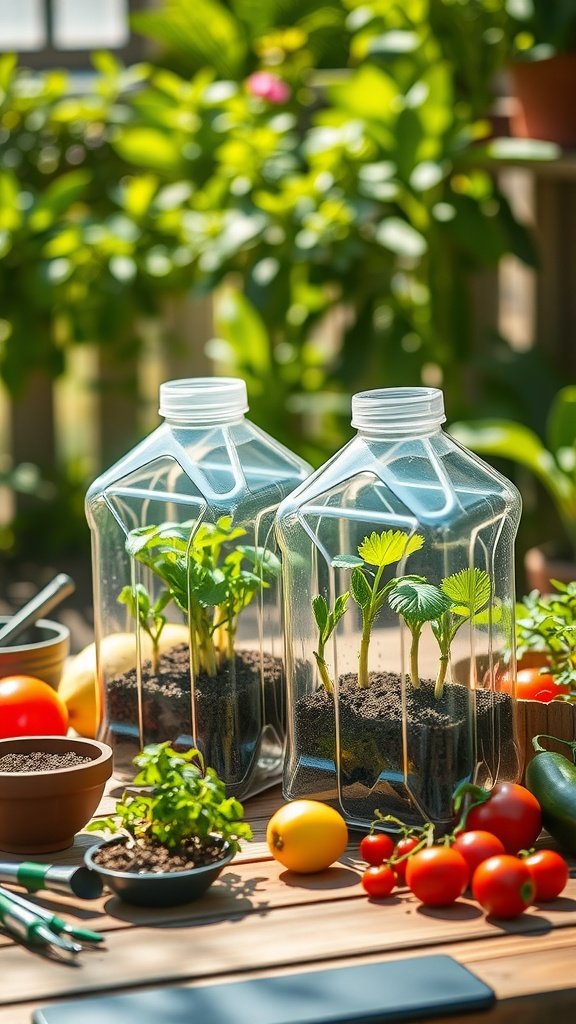
Using plastic bottles as mini greenhouses is a smart way to protect your seedlings. In the image, you can see two clear plastic bottles filled with soil and young plants. This setup allows sunlight to reach the seedlings while keeping them safe from harsh weather.
The bottles create a warm environment that encourages growth. As moisture accumulates inside, your plants stay hydrated without constant watering. It’s like giving them a cozy little home!
You can easily make your mini greenhouse by cutting a bottle in half, putting soil and seedlings inside, and then placing the top half back on. Just remember to remove the cap to allow airflow. This simple hack helps your garden thrive!
Start Seeds Indoors To Extend Your Growing Season.
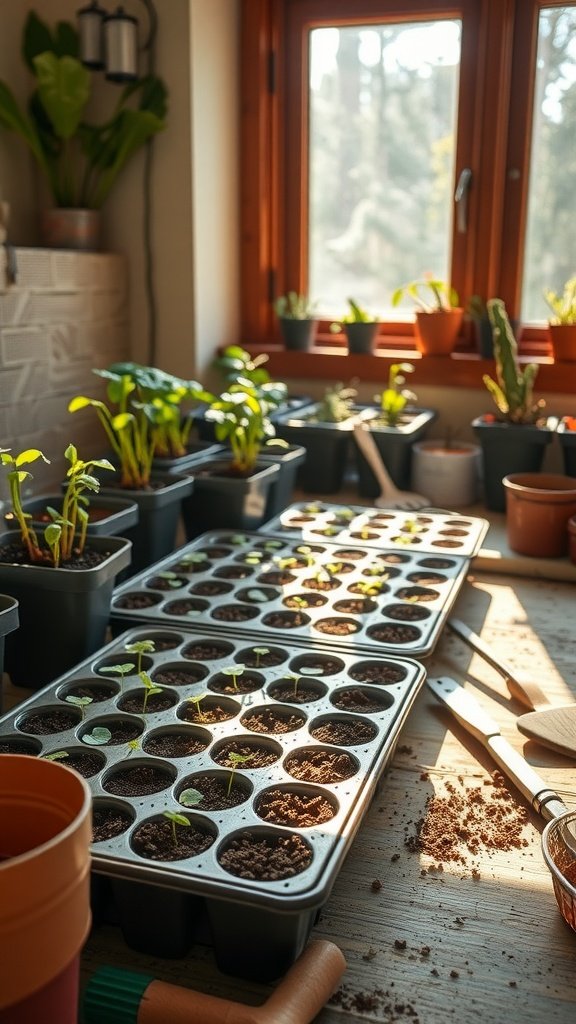
Starting seeds indoors is a fantastic way to get a jump on your gardening season. The image shows a cozy setup filled with young plants peeking up from their soil-filled cells. With plenty of sunlight streaming in through the window, these little green shoots are soaking up the energy they need to thrive.
Using seed trays like the ones in the picture maximizes space and makes it easy to monitor growth. You can see the excitement in those fresh seedlings! Each tiny plant holds the promise of a bountiful harvest.
This method allows you to extend your growing season. By starting seeds indoors, you can plant earlier and protect delicate young plants from late frosts. You’ll be reaping rewards from your garden well before others who wait for warmer weather.
Use Crushed Eggshells To Improve Soil Ph And Deter Pests.
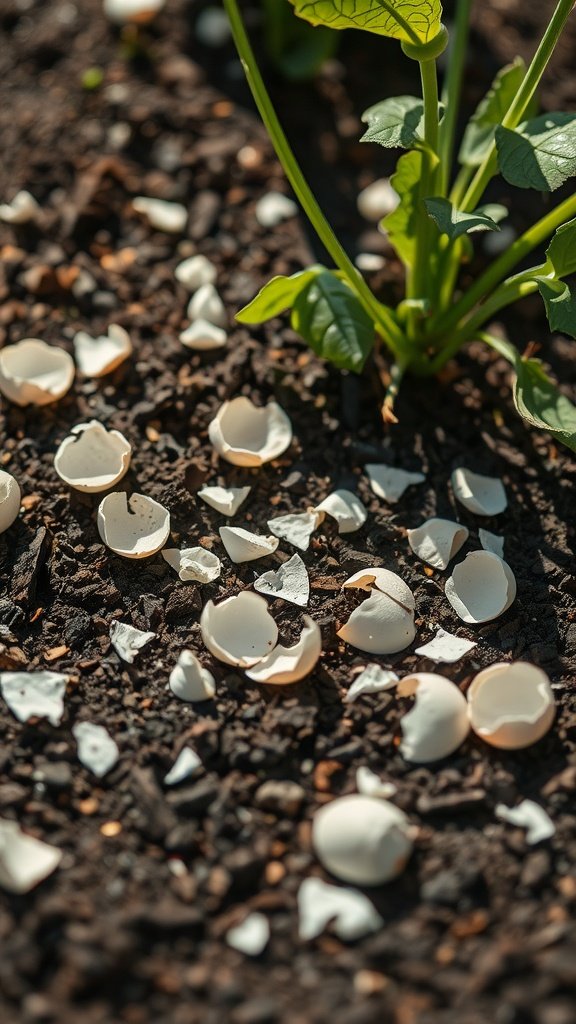
Crushed eggshells are a fantastic addition to your vegetable garden. This simple hack not only helps improve soil pH but also acts as a barrier against pests. In the image, you can see scattered eggshell pieces on the soil around healthy green plants. They blend in nicely while providing essential nutrients to the earth.
Eggshells are primarily made of calcium carbonate, which can help balance soil acidity. When you crush them and mix them into your garden soil, they slowly break down, releasing calcium over time. This is especially beneficial for crops like tomatoes and peppers, which thrive in slightly more alkaline conditions.
On the pest side, the sharp edges of crushed shells can deter soft-bodied insects like slugs and snails. These creatures will think twice before crossing a rough terrain of crushed shells. Using this natural method, you can keep your garden thriving without relying on harsh chemicals.
Next time you make breakfast, save those eggshells! Rinse them, dry them out, and crush them before adding them to your garden. It’s an easy and eco-friendly way to boost your soil and protect your plants.
Harvest Rainwater With Barrels For Eco-Friendly Irrigation.
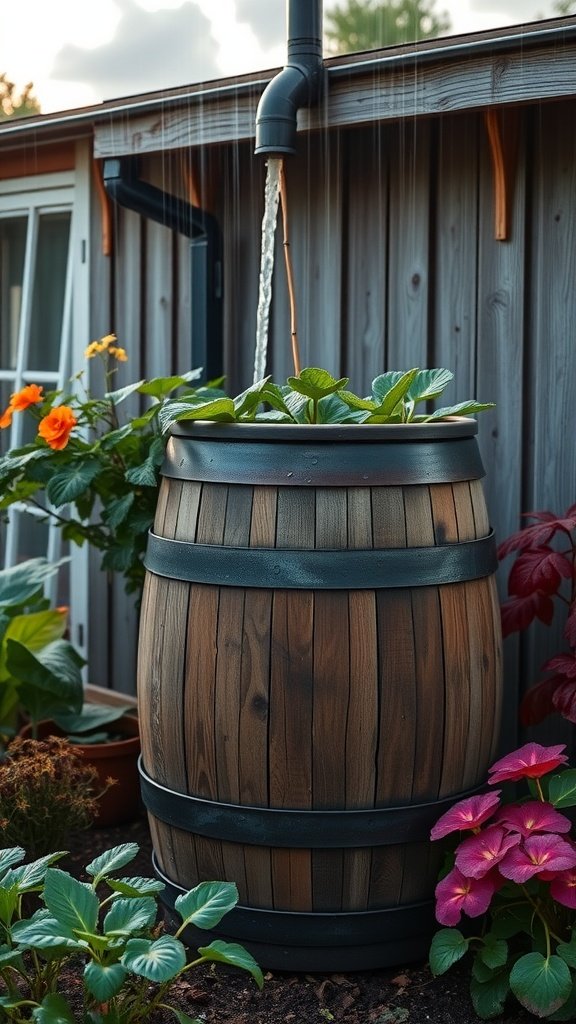
Harvesting rainwater is a smart way to water your garden while being kind to the environment. The image shows a wooden rain barrel positioned neatly beside a cozy garden shed. Rainwater cascades from the roof into the barrel, showcasing a simple yet effective irrigation method.
Using rain barrels not only saves water but also lowers your water bill. It’s a straightforward project to set up. Just place a barrel under your gutter’s downspout. When it rains, the barrel collects water that can be used later for watering plants. This method ensures your garden stays hydrated during dry spells.
The vibrant flowers and greenery surrounding the barrel in the image highlight how well this system can blend into your garden. With a bit of effort, you can create an eco-friendly watering solution that benefits both your plants and the environment.
